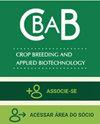Genetic diversity and structure of Hancornia speciosa Gomes populations characterized by microsatellites markers
IF 1.1
4区 农林科学
Q2 Agricultural and Biological Sciences
引用次数: 2
Abstract
Hancornia speciosa Gomes, a native fruit tree, plays an important socio-economic role in Brazil’s traditional communities. The objective was to estimate the genetic structure of 176 individuals from eight locations in the Cerrado, Caatinga and Atlantic Forest biomes, based on six microsatellite markers. The analyzes revealed the formation of five population groups: APernambuco, Paraíba and Sergipe (Atlantic Forest), BMaranhão (Cerrado); both, var. speciosa, CBahia (Caatinga / Cerrado transition zone) and Ceará (Caatinga), DGoiás (Cerrado) and EMinas Gerais (Cerrado,) being groups C, D and E possibly var. pubescens. Most of the genetic variation is within the groups (65.61%, Fst = 0.34, p <0.001). Although group A had the highest Ho (0.66), it had a negative fixation index (f = -0.02), while the other had positive values. Our results revealed high levels of genetic diversity and provide support the development of more efficient conservation strategies for H. speciosa.基于微卫星标记的黄颡鱼种群遗传多样性及结构分析
山茱萸是一种当地的果树,在巴西的传统社区中扮演着重要的社会经济角色。目的是基于6个微卫星标记,估计来自塞拉多、卡廷加和大西洋森林生物群系8个地点的176个个体的遗传结构。分析揭示了五个种群的形成:APernambuco, Paraíba和Sergipe(大西洋森林),bmaranh(塞拉多);CBahia (Caatinga / Cerrado过渡区)和cerar (Caatinga), DGoiás (Cerrado)和EMinas Gerais (Cerrado)都是C, D和E组,可能是不同的短柔毛。遗传变异主要发生在群体内(65.61%,Fst = 0.34, p <0.001)。虽然A组的Ho值最高(0.66),但其固定指数为负(f = -0.02),而另一组为正。本研究结果揭示了高水平的遗传多样性,为开发更有效的物种保护策略提供了支持。
本文章由计算机程序翻译,如有差异,请以英文原文为准。
求助全文
约1分钟内获得全文
求助全文
来源期刊
CiteScore
2.40
自引率
13.30%
发文量
25
审稿时长
6-12 weeks
期刊介绍:
The CBAB – CROP BREEDING AND APPLIED BIOTECHNOLOGY (ISSN 1984-7033) – is the official quarterly journal of the Brazilian Society of Plant Breeding, abbreviated CROP BREED APPL BIOTECHNOL.
It publishes original scientific articles, which contribute to the scientific and technological development of plant breeding and agriculture. Articles should be to do with basic and applied research on improvement of perennial and annual plants, within the fields of genetics, conservation of germplasm, biotechnology, genomics, cytogenetics, experimental statistics, seeds, food quality, biotic and abiotic stress, and correlated areas. The article must be unpublished. Simultaneous submitting to another periodical is ruled out. Authors are held solely responsible for the opinions and ideas expressed, which do not necessarily reflect the view of the Editorial board. However, the Editorial board reserves the right to suggest or ask for any modifications required. The journal adopts the Ithenticate software for identification of plagiarism. Complete or partial reproduction of articles is permitted, provided the source is cited. All content of the journal, except where identified, is licensed under a Creative Commons attribution-type BY. All articles are published free of charge. This is an open access journal.

 求助内容:
求助内容: 应助结果提醒方式:
应助结果提醒方式:


